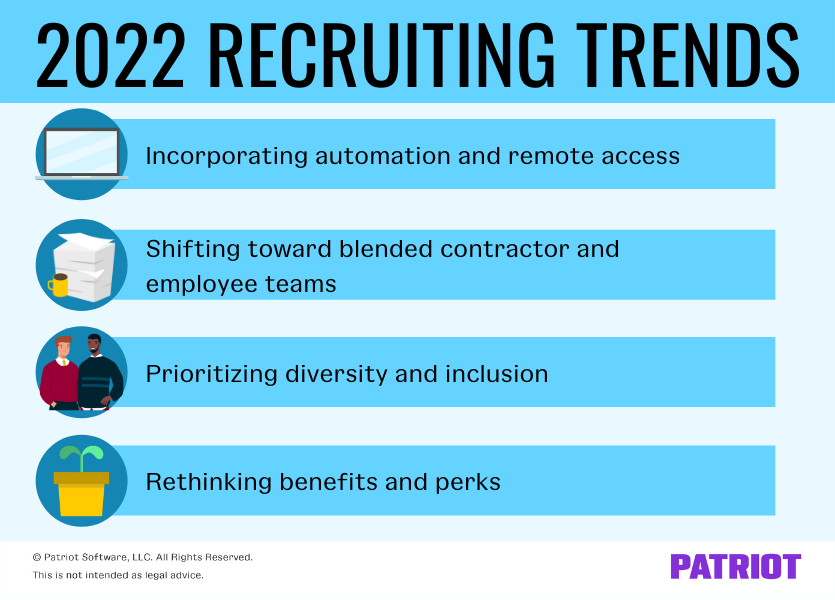Everyone in the world has experienced some form of impact in employment caused by the global pandemic. For some, this meant losing a job and a sense of job security. For others, this meant moving to a remote working environment rather than enjoying the camaraderie of an office. Small businesses, in particular, bore the brunt of the global impacts, and are still struggling to find employees as a result.
Everyone experienced change.
COVID changed the world. As a result, it changed recruiting practices, too. Read on to learn about 2022 recruiting trends and what they mean for small businesses.
2022 Recruiting trends and what they mean for small businesses
Here are some of the 2022 recruiting trends shaped by the ongoing COVID-19 pandemic and pivots.

1. Incorporating automation and remote access
Many of the trends influenced by COVID-19 aren’t new but rather an acceleration of changes already taking place. Many companies were incorporating automation into their hiring process, implementing an applicant tracking system (ATS) for AI-driven candidate vetting and creating centralized onboarding processes. Before the pandemic, resume specialists were already aware of the value of ATS optimization for applicants and walking that fine line between appealing to both human hiring managers and their robotic systems.
Automation World’s 2021 survey showed an 11% increase from 2019 in companies leveraging cloud computing as part of an overarching digital transformation. While many companies were moving in this direction, automation and remote access shifted to the top of the priority list over the past year.
As many small businesses have shifted to a remote work model, it’s essential to have access to this information from a remote location, as stopping by the office is no longer the standard. Furthermore, everything from interviews to onboarding also takes place remotely, enhancing the need for streamlined, cloud-based systems and tools.
2. Shifting toward blended contractor and employee teams
Another trend that experienced acceleration during the pandemic and is expected to become the norm this year is creating a blend of full-time employees and contractors. The sudden overnight shift to remote work and worldwide layoffs has inspired many former employees to offer their skills as freelancers and contractors.
This shift offers benefits to both the contractor and the employer. From the contractor’s standpoint, it keeps their options open during uncertain times and realizes a dream of self-employment. Employers experience the benefit of having less responsibility or bureaucracy regarding benefits and labor laws.
Perhaps the biggest change over the past two years is the ability to cast a wider net when seeking top talent. As many companies embrace a permanent remote work structure, hiring managers have the bandwidth to source talent nationwide rather than focusing on a specific geographic location. While this trend creates more competition for job seekers, it’s a huge opportunity for businesses.
Want to impress your friends at a dinner party?
Get the latest small business news delivered straight to your inbox.
Subscribe to Email List3. Prioritizing diversity and inclusion
One bright spot of COVID-19 and the radical changes that occurred during unprecedented times is a renewed focus on representation in hiring and leadership. Eighty-five percent of companies responded that they were discussing racial injustice within the workplace. Industry giants like Facebook and Proctor & Gamble have set actionable goals to increase diversity within the organization.
For hiring managers, this shift means re-shaping the hiring lens and processes to level the playing field. Implementing ATS and other automated hiring and onboarding platforms can help remove unconscious bias to promote more equitable hiring practices.
4. Rethinking benefits and perks
Many brands are being forced to rethink the benefits and perks they offer employees— having an amazing office with free snacks isn’t a great benefit if no one can go there anymore.
Since the pandemic, understanding what appeals to talent has shifted, which impacts how a recruiter markets a brand to top talent. There’s a renewed focus on mental health and flexibility, re-humanizing employees as more than just workers.
Benefits like work-from-home reimbursement or monthly care packages boost employee engagement while your team works from home. Some brands are even offering pet adoption fee coverage and insurance options.
The key takeaway is that it may be time to rethink traditional employee perks to adapt to the new normal.
Final thoughts
As many businesses come out of their hiring freezes and adjust to new processes, these new and accelerated trends are expected to drive recruiting practices in 2022.
Like the employees you source, you must be adaptable and willing to embrace change as we navigate the ongoing impacts of COVID-19.
This is not intended as legal advice; for more information, please click here.
These views are made solely by the author.



